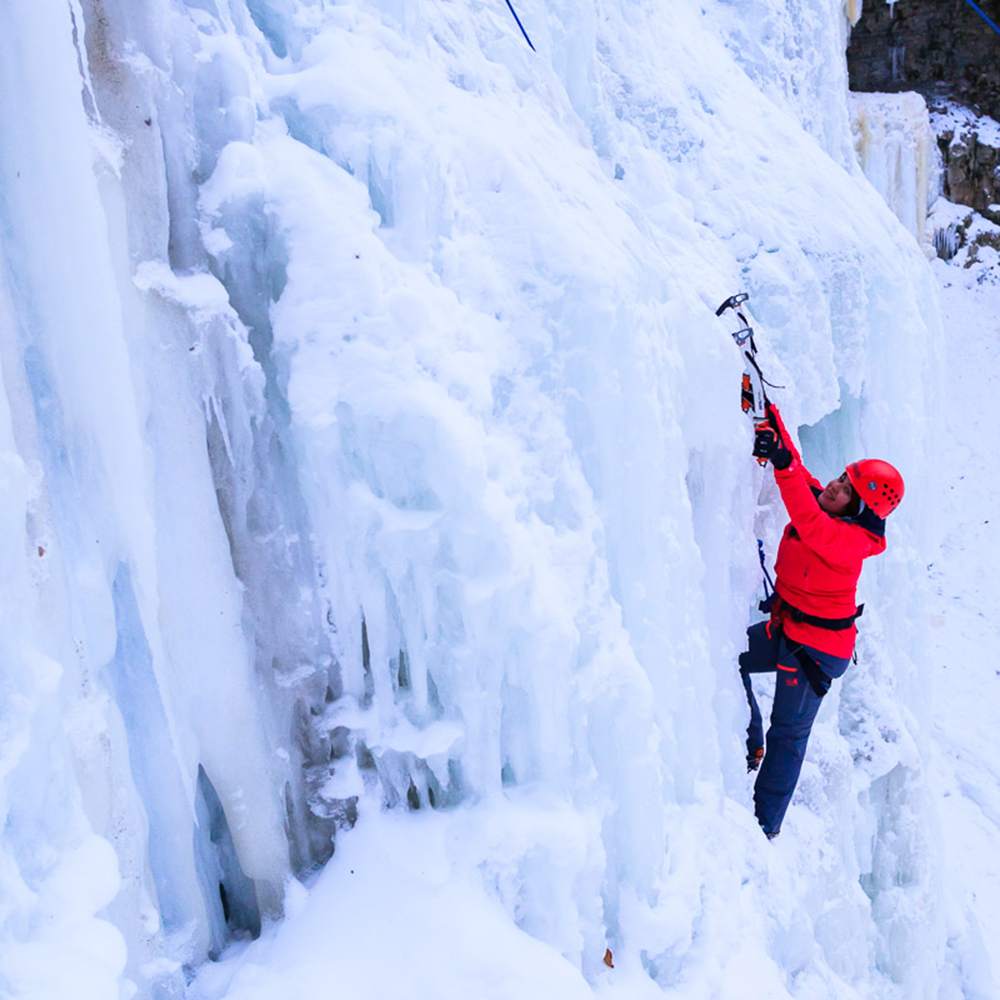
It’s the dead of Canadian winter and the temperature sits several degrees below zero. But for the first time in my life, I am thankful for this because the ice I’m clinging to feels quite sturdy.
My gloved hands grip two large axes. I swing one high above my head, hoping to sink it into the perfect spot on the ice. I give it my all. Once, twice, thrice. No luck.
I squint my eyes and press my lips together as pellets of broken ice fly into my face.
Finally after the fourth try, I hear my axe sink in for a good stick.
Thwick!
My legs feel off balance as I perch on the tips of my toes, trying to keep the tiny spikes on my boots planted firmly into the ice. My hands tremble and my shoulders start to give in from exhaustion. My breath shortens as I struggle to take quick sips of cold, dry air. Yet with every step that I climb higher, there is a little boost of confidence, and that little voice inside my head gets a bit louder telling me: “you can do this!”
Winter and I have never been good friends, and so spending an afternoon clinging to a frozen waterfall seemed like an absurd idea at first. But I gave it a shot, hoping that immersing myself in an outdoor winter sport will help me not hate winter anymore. Turns out, I was right.
Although ice climbing can be quite challenging for first timers, it definitely isn’t an impossible feat. With a good instructor and a beginner level spot for your first climb, you’ll be on your way to falling in love with a new sport. Here’s some advice to get you started.
Court your outfitter
Before you slap down your credit card, make sure what you’re signing up for is right for you. Rather than just booking something online, pick up the phone and speak to the tour company to get more details on the adventure. Describe your fitness level and experience and have them evaluate what type of climb is right for you.
For my first climb, I went with Ontario based ONE AXE Pursuits. They suggested I join up with a beginners group at Tiffany Falls in Ancaster, Ontario. Just minutes into my conversation with owner and tour leader, Frederick Schuett, my nervousness started to fade away. His calm and collected manner was exactly what I needed before tackling what at first seemed like an impossible task. ONE AXE provided all the necessary equipment and training so all I had to do was dress warm and show up.
So yea, bundle up!
A day of ice climbing is a day spent outside in the sub-zero temperature surrounded by ice. Obviously it’s going to be cold while you’re standing around, so make sure you bundle up appropriately. Once you start climbing, however, your body warms up very quickly. It’s crucial to dress in layers that you can take off and put back on in order to manage your body temperature through the day.
My layering system worked perfectly for me on a day when the temperature hovered around -8 degrees Celsius and there was minimum wind. Here’s what I wore:
Top
- A soft, itch-free merino wool t-shirt to keep my core super warm
- A thicker long-sleeved base layer for greater coverage and moisture wicking power
- A light fleece-lined zip-up with stay-in-place sleeves and a fitted hood that I pulled over my toque
- A full-sleeved 100% wool sweater
- A waterproof breathable shell with a helmet compatible hood
Bottom
- Heavyweight technical tights
- Insulated pants with a waterproof-breathable exterior
Accessories
- A toque
- A fleece neck gaiter
- A pair of warm, waterproof, and super grippy ice climbing gloves
Stashed in my favourite daypack, I carried a down jacket and a pair of insulated glovesfor extra warmth when I wasn’t climbing. You’ll need both of these items when belaying for your climbing partner. Depending on how cold it is you will likely need to put on extra layers under your shell to keep yourself warm. Your best bet is to follow the standard rules for layering and then adjust your outfit according to how cold it gets. Always carry a few extra piece of clothing just in case.
Stay hydrated and nourished
Even if you’re tackling a small frozen waterfall, ice climbing is hard work! Make sure to carry plenty of water and snacks with you for the day. I’m personally addicted to the chocolate mint flavoured Cliff bars, but any protein-rich energy bar or energy gel will keep you nourished through the day. Sipping from a thermos full of hot tea is a great way of keeping warm and hydrated. Avoid eating a heavy lunch during your climbing trip – that’ll just make you feel sluggish – but do start the day off with a nice big breakfast.
Ask the right questions
Your first ice-climbing trip will begin with a short lesson during which you may feel a little overwhelmed with all the information. Don’t let that discourage you. The key is to focus on the safety information and the work you have to do, and let your tour guides help you with the rest.
Learn the proper technique for a good swing with your ice tools and how to tell if you have a good stick – you’ll learn to recognize the distinct thwick sound when your ice tool hits a good spot on the ice. The trickier part is learning how to kick in your crampons (the spiky attachment on your boots), but with a bit of practice you’ll get the hang of this as well. Speak up with your questions and ask your guide to demonstrate the technique until you’re comfortable doing it on your own.
Have some faith
The tiny ridges on your ice axes, and the little spikes on your feet don’t feel very secure at first. But you’ll quickly realize that both of these tools can grip solidly even if they are inserted only a few centimetres into the ice. After all, they are specifically designed for this activity.
There will be times when your tools will come loose from the ice, your foot will slip and you may even – gasp – fall! And if that happens, your harness is there to hold you. I fell several times during my first vertical climb, and none of those falls were more than a few inches. Put your trust in the equipment and focus your mental energy on perfecting your technique.
Take your time
The first few steps you take in your crampons will make you feel like you’re learning to walk all over again. Your first few swings of the tools will probably spew chunks of ice in your face instead of resulting in a good stick. Don’t get discouraged. Just keep practicing and after several tries, you’ll start to get a hang of it.
Ice climbing is not a competitive sport and so you are not racing with anyone. Slow down your pace and focus on your technique as you slowly make your ascent. Because you’re carving your own way, climbing ice is also a lot more exhausting than climbing rock. Take long breaks between climbs and remember if you get tired in the middle of a climb, you can lean back into your harness and take a break while suspended in the air. Technique is more important than power, Frederick points out, so focus on swinging your axe correctly, rather than swinging it hard.
Ultimately, the most important thing to remember are the words Frederick yelled out to me when I was about to give up.
“Determination will get you to the top,” he said.
When your arms are exhausted and your feet are shaky, that’s just the tool to reach for to keep you moving ahead. Having an encouraging voice down at the belay urging you to keep reaching for the next spot to pick helps too.
Best places for first time ice climbing
ONE AXE Pursuits – Ancaster, Ontario
Canada West Mountain School – Pemberton or Whistler B.C.
Summit Mountain Guides – Several locations across the Canadian Rockies
Mountain Sense – Canmore, Alberta or Nelson B.C.
Parc d’escalade de la Montagne D’Argent – The Laurentians, Quebec
Attitude Montagne – The Laurentians, Quebec
Quick facts: Hamilton
Best time to visit: Weather can vary from year to year, but generally the ideal ice conditions fall between the months of January and March. There is an abundance of hiking, snowshoeing and cross-country skiing along the Bruce Trail, Canada’s oldest and longest footpath. For those looking for something a little less adventurous, Pier 8 is a great place for some family-friendly skating and there are more than 100 beautiful frozen waterfalls to see in this waterfall capital of the world.
Do treat yourself to some rest and relaxation after a hard day of work. A stay at theSerenity Ranch is a perfect complement to an ice climbing adventure in Hamilton. Surrounded by beautiful farmland, the Serenity Ranch has perfected the art of hospitality down to every last detail. This beautiful little BnB is decorated with class and has in-room amenities that trump even the most luxurious hotels and resorts. Let your sore muscles soak in the hot tub, fall asleep next to a fireplace and wake up in the morning to a delicious breakfast prepared fresh by the owner himself.

Don’t visit without a car. Although many of the downtown Hamilton attractions are easily accessed by public transit, many of the hiking trails and waterfalls require access to a vehicle.
Leave a Reply